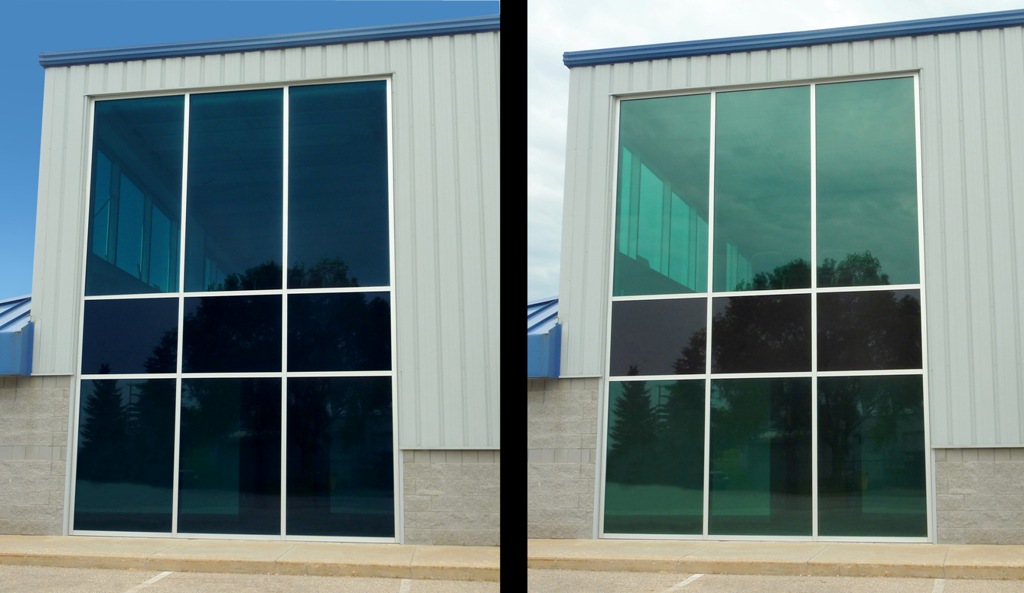PPG Industries and Pleotint, LLC, have agreed to jointly market a commercial window glass system that combines Sunlight Responsive Thermochromic, or SRT, interlayer technology by Pleotint, with Solarban low-emissivity (low-e) glass and other glasses by PPG to control solar heat gain and reduce energy costs in buildings.
Pleotint’s patented technology is a lightly tinted thermochromic interlayer that warms up and darkens in direct sunlight, but clears in indirect sunlight to allow light to pass into a building. Laminated between two lites of glass, SRT interlayer may be used monolithically or within an insulating glass unit. Visible light transmittance for windows with SRT interlayer adjusts through the day without the need for wiring, power supplies or controls.
When the SRT interlayer is combined in a window system with Solarban glass, a proven solar control, low-e glass that also blocks solar heat and transmits visible light, these adaptive windows can dramatically reduce the amount of energy required to cool buildings. Because the windows clear up in indirect sunlight, they also decrease the need for artificial lighting.
A study showed that, due to its ability to dynamically adjust to natural lighting conditions, a window system including an SRT interlayer can reduce energy costs in commercial buildings by 17 to 30% over industry-standard window systems. A window with SRT technology also reduces the transmittance of ultraviolet light and short-wavelength visible light, which are major contributors to fading in carpets, fabrics, artwork, photos and other materials.
Unlike competing dynamic windows that require manual, electrical or mechanical controls, windows with the SRT interlayer use the sun’s own energy – up to 1,000 watts of power per square meter – to adjust the window tint and transmittance level. Because the process is entirely self-sustaining, the SRT interlayer system not only uses less energy, it also eliminates the opportunities for failure due to faulty wiring, poor connections or broken electrical circuits. Windows with SRT interlayers also have passed exposure and durability testing developed for electrochromic windows and conducted by the National Renewable Energy Laboratory (NREL).
Insulating units with SRT interlayers and Solarban low-e glass are available in sizes up to 5 feet wide and have been laminated in lengths of up to 11 feet. Architects may specify any Oceans of Color tinted glass or Earth and Sky high-performance tinted glass by PPG as a base-state window color. BD+C
Related Stories
| Aug 11, 2010
Walt Disney Family Museum planned in San Francisco
Construction is under way on a new museum dedicated to the man behind the Disney empire. Set to open this fall in San Francisco, the Walt Disney Family Museum will feature 10 galleries, starting with Disney's beginnings on a Missouri farm.
| Aug 11, 2010
SAFTI FIRST hires Tim Nass as National Sales Manager
SAFTI FIRST, a leading USA manufacturer of fire rated glazing and framing systems, is pleased to announce the addition of Tim Nass as National Sales Manager. In his new role, Tim will be working closely with architects and contract glaziers in selecting the appropriate and most economical fire rated glazing solution for their project. He will also be coordinating SAFTI FIRST’s extensive network of architectural representatives throughout the United States.
| Aug 11, 2010
NCARB welcomes new board of directors
The National Council of Architectural Registration Boards (NCARB) introduces its Board of Directors for FY10, who were installed during the culmination of the Council’s 90th Annual Meeting and Conference in Chicago.
| Aug 11, 2010
Berkebile wins $100K award for commitment to environment
Robert Berkebile, the founding principal of BNIM Architects and a founding member of the U.S. Green Building Council, has been selected to receive a $100,000 Heinz Award. The award honors his role in promoting green building design and for his commitment and action toward restoring social, economic, and environmental vitality to America’s communities through sustainable architecture and planning.
| Aug 11, 2010
Polshek Partnership unveils design for University of North Texas business building
New York-based architect Polshek Partnership today unveiled its design scheme for the $70 million Business Leadership Building at the University of North Texas in Denton. Designed to provide UNT’s 5,400-plus business majors the highest level of academic instruction and professional training, the 180,000-sf facility will include an open atrium, an internet café, and numerous study and tutoring rooms—all designed to help develop a spirit of collaboration and team-oriented focus.
| Aug 11, 2010
University of Florida aiming for nation’s first LEED Platinum parking garage
If all goes as planned, the University of Florida’s new $20 million Southwest Parking Garage Complex in Gainesville will soon become the first parking facility in the country to earn LEED Platinum status. Designed by the Boca Raton office of PGAL to meet criteria for the highest LEED certification category, the garage complex includes a six-level, 313,000-sf parking garage (927 spaces) and an attached, 10,000-sf, two-story transportation and parking services office building.
| Aug 11, 2010
Draft NIST report on Cowboys practice facility collapse released for public comment
A fabric-covered, steel frame practice facility owned by the National Football League’s Dallas Cowboys collapsed under wind loads significantly less than those required under applicable design standards, according to a report released today for public comment by the Commerce Department's National Institute of Standards and Technology (NIST).







